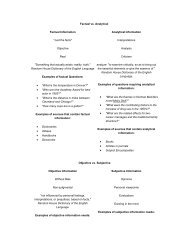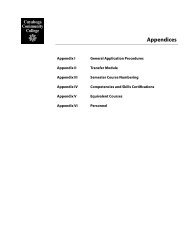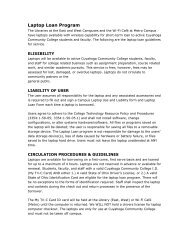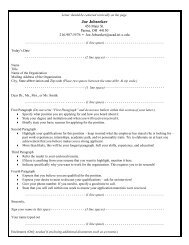Gilgamesh Chen Translation.pdf
Gilgamesh Chen Translation.pdf
Gilgamesh Chen Translation.pdf
Create successful ePaper yourself
Turn your PDF publications into a flip-book with our unique Google optimized e-Paper software.
REFERENCES<br />
The Epic of <strong>Gilgamesh</strong>, trans. by Maureen Gallery Kovacs (Stanford: Stanford University Press,<br />
1990)<br />
<strong>Gilgamesh</strong>, translated by John Maier and John Gardner (New York: Vintage, 1981)<br />
SOME SOURCES<br />
Diakonoff, I.M. “Ancient Writing and Ancient Written language: Sumerian,” 1982<br />
Hayes, T. “Sumerian,” 1997<br />
Jacobsen, Thorkild. “The King List”, 1939<br />
Jones, T. “The Sumerian Problem,” 1969<br />
Kramer S.N. Many books but for this page we read “<strong>Gilgamesh</strong> and the Huluppa Tree,” 1938<br />
(Text and <strong>Translation</strong>, Chapter 1)<br />
Pritchard J.B., ed. “Ancient Near Eastern Texts Relating to the Old Testament,” 1969<br />
Saunders, N.K. “<strong>Gilgamesh</strong>: The Epic of <strong>Gilgamesh</strong>,” 1972 (this is a literary translation)<br />
Thomsen, M. “The Sumerian Language,” 1984<br />
Tigay A. “The Evolution of the <strong>Gilgamesh</strong> Epic,”1982<br />
Notes for Translating the Epic of <strong>Gilgamesh</strong><br />
© 1995-2001 Untangle Incorporated<br />
Last Updated: Monday, October 29, 2001<br />
The Epic is not one story written one time by one person. It was many different stories (Tigay,<br />
Chapter 1) which were brought together and extensively rewritten so as to make a story. When<br />
was this done? It seems that in what scholars of the area call the old Babylonian period (2000-<br />
1600 years ago. Tigay pp 11).<br />
The first tablets found contain what has become the Standard Version of the Epic. These are<br />
Babylonian tablets written in Akkadian, found in the remains of the library (668-627 B.C.) at<br />
what used to be a city of Ninevah in what is now Iraq. They were found by A.H. Layard in 1839<br />
(Saunders, pp 9) and no one could understand then what they said at all.<br />
From other tablets listing the Kings of Sumer (Jacobsen pp 84-89 & Pritchard pp 266) we find<br />
<strong>Gilgamesh</strong> listed as a king of the city of Uruk about 2700 B.C. So the story occurred at least<br />
2000 years before the tablets were in the library in Ninevah.<br />
The earliest Sumerian tablets are about 3100 years ago, or about 400 years after <strong>Gilgamesh</strong><br />
reigned. According to Tigay these early stories were about <strong>Gilgamesh</strong> the man and heroic king.<br />
The standard version has revised these entertaining stories into generalized statements about<br />
mankind illustrated by <strong>Gilgamesh</strong>‟s life.

















